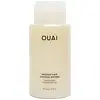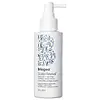What's inside
What's inside
 Key Ingredients
Key Ingredients

 Benefits
Benefits

 Concerns
Concerns

 Ingredients Side-by-side
Ingredients Side-by-side

Water
Skin ConditioningSodium C14-16 Olefin Sulfonate
CleansingCocamidopropyl Betaine
CleansingSodium Methyl Cocoyl Taurate
CleansingCocamide Mipa
EmulsifyingGlycol Distearate
EmollientParfum
MaskingAmodimethicone
Hydroxypropyl Guar Hydroxypropyltrimonium Chloride
Glycerin
HumectantCitrus Japonica Fruit Extract
Skin ConditioningPanthenol
Skin ConditioningHydrolyzed Keratin
HumectantPolyquaternium-7
Orbignya Oleifera Seed Oil
EmollientCocos Nucifera Oil
MaskingPEG-150 Distearate
EmulsifyingSodium Lauroyl Glycinate
CleansingCetrimonium Chloride
AntimicrobialC11-15 Pareth-7
EmulsifyingLaureth-9
EmulsifyingTrideceth-12
EmulsifyingCocoglucosides Hydroxypropyltrimonium Chloride
CleansingAcrylates Copolymer
Tocopherol
AntioxidantPEG-200 Hydrogenated Glyceryl Palmate
CleansingPEG-7 Glyceryl Cocoate
EmulsifyingDisodium EDTA
Citric Acid
BufferingSodium Chloride
MaskingSodium Hydroxide
BufferingTetrasodium EDTA
Phenoxyethanol
PreservativeSodium Benzoate
MaskingPotassium Sorbate
PreservativeBenzyl Alcohol
PerfumingBenzyl Salicylate
PerfumingLimonene
PerfumingHexyl Cinnamal
PerfumingCI 15985
Cosmetic ColorantWater, Sodium C14-16 Olefin Sulfonate, Cocamidopropyl Betaine, Sodium Methyl Cocoyl Taurate, Cocamide Mipa, Glycol Distearate, Parfum, Amodimethicone, Hydroxypropyl Guar Hydroxypropyltrimonium Chloride, Glycerin, Citrus Japonica Fruit Extract, Panthenol, Hydrolyzed Keratin, Polyquaternium-7, Orbignya Oleifera Seed Oil, Cocos Nucifera Oil, PEG-150 Distearate, Sodium Lauroyl Glycinate, Cetrimonium Chloride, C11-15 Pareth-7, Laureth-9, Trideceth-12, Cocoglucosides Hydroxypropyltrimonium Chloride, Acrylates Copolymer, Tocopherol, PEG-200 Hydrogenated Glyceryl Palmate, PEG-7 Glyceryl Cocoate, Disodium EDTA, Citric Acid, Sodium Chloride, Sodium Hydroxide, Tetrasodium EDTA, Phenoxyethanol, Sodium Benzoate, Potassium Sorbate, Benzyl Alcohol, Benzyl Salicylate, Limonene, Hexyl Cinnamal, CI 15985
Water
Skin ConditioningPropanediol
SolventArginine
MaskingBetaine
HumectantSalicylic Acid
MaskingLactic Acid
BufferingGluconolactone
Skin ConditioningMelaleuca Alternifolia Leaf Oil
AntioxidantMentha Piperita Oil
MaskingSodium PCA
HumectantPanthenol
Skin ConditioningHyaluronic Acid
HumectantCharcoal Powder
AbrasivePolyglyceryl-4 Caprate
EmulsifyingMethyl Diisopropyl Propionamide
MaskingZingiber Officinale Root Oil
MaskingBenzyl Alcohol
Perfuming
 Reviews
Reviews

Alternatives
Ingredients Explained
These ingredients are found in both products.
Ingredients higher up in an ingredient list are typically present in a larger amount.
Benzyl Alcohol is most commonly used as a preservative. It also has a subtle, sweet smell. Small amounts of Benzyl Alcohol is not irritating and safe to use in skincare products. Most Benzyl Alcohol is derived from fruits such as apricots.
Benzyl Alcohol has both antibacterial and antioxidant properties. These properties help lengthen the shelf life of products. Benzyl Alcohol is a solvent and helps dissolve other ingredients. It can also improve the texture and spreadability.
Alcohol comes in many different forms. Different types of alcohol will have different effects on skin. This ingredient is an astringent alcohol.
Using high concentrations of these alcohols are drying on the skin. They may strip away your skin's natural oils and even damage your skin barrier. Astringent alcohols may also irritate skin.
Other types of astringent alcohols include:
According to the National Rosacea Society based in the US, you should be mindful of products with these alcohols in the top half of ingredients.
Any type of sanitizing product will have high amounts of alcohol to help kill bacteria and viruses.
Learn more about Benzyl AlcoholPanthenol is a common ingredient that helps hydrate and soothe the skin. It is found naturally in our skin and hair.
There are two forms of panthenol: D and L.
D-panthenol is also known as dexpanthenol. Most cosmetics use dexpanthenol or a mixture of D and L-panthenol.
Panthenol is famous due to its ability to go deeper into the skin's layers. Using this ingredient has numerous pros (and no cons):
Like hyaluronic acid, panthenol is a humectant. Humectants are able to bind and hold large amounts of water to keep skin hydrated.
This ingredient works well for wound healing. It works by increasing tissue in the wound and helps close open wounds.
Once oxidized, panthenol converts to pantothenic acid. Panthothenic acid is found in all living cells.
This ingredient is also referred to as pro-vitamin B5.
Learn more about PanthenolWater. It's the most common cosmetic ingredient of all. You'll usually see it at the top of ingredient lists, meaning that it makes up the largest part of the product.
So why is it so popular? Water most often acts as a solvent - this means that it helps dissolve other ingredients into the formulation.
You'll also recognize water as that liquid we all need to stay alive. If you see this, drink a glass of water. Stay hydrated!
Learn more about Water